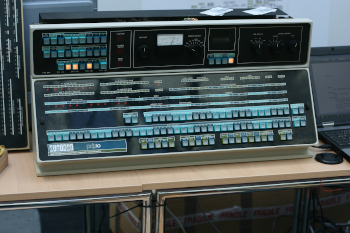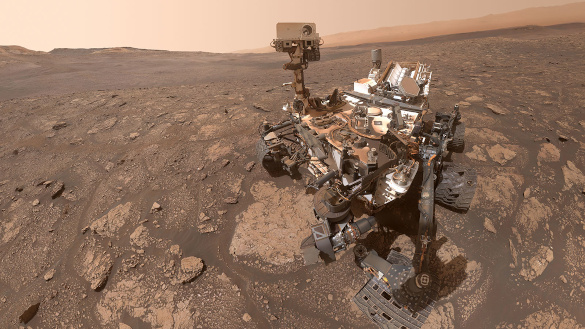Martian Radiation
August 29, 2022
Manufacturers enhance the
saleability of even
mundane products through the addition of
technology. Sometimes, the added technology has no real benefit.
Consumer electronics often has a multitude of
manual controls and
blinking lights that are just
eye candy. I remember how early
desktop computers would have a
digital display showing the change in
processor speed when the
turbo button was pressed. What was displayed wasn't an actual
frequency measurement, just a
stored number. This
concept goes back to early
mainframe computers and
der Blinkenlichten (the blinkenlights).

Eye candy and blinkenlights - A Digital Equipment Corporation PDP-10 mainframe computer.
The hundreds of indicator lamps on early models were incandescent, but they were eventually replaced by light-emitting diodes. A now forgotten trick to increase the life of frequently switched incandescent bulbs is to hold them at a low current when "off" and not switch them entirely off.
About 1500 units of the PDP-10 were sold from 1968-1983. Although I wasn't able to find a selling price, a good estimate would be about $140,000 for a typical configuration, which is about a quarter of a million dollars in today's money.
One of the first online service providers, CompuServe, operated more than 200 PDP-10s at its peak. As they say, you need to spend money to make money.
(Wikimedia Commons image by Wolfgang Stief. Click for larger image.)
Sometimes the added technology was intended to satisfy a real need, although its actual implementation was likely not that effective. In the
1960s, our
family had a
clothes washer with an
ultraviolet lamp intended as an
antimicrobial aid. In those days, such lamps were
fluorescent, and the idea of having something like that inside a
water-filled
container seems
dangerous by today's
standards. Clothes washers still have UV lamps, but the UV source is now an array of light-emitting diodes.
During the
COVID-19 pandemic, there was a
fear that the
coronavirus could be
transmitted on
surfaces, and there were UV devices sold that allowed
sterilization of your
mail, but my family took a different approach of letting our mail
age for a few days before opening. UV
radiation is now used effectively for sterilization of
hospital rooms.
Short-wavelength UV (UV-C), known as
germicidal UV, has
wavelengths between about 200-280
nanometers, and it's strongly
absorbed by
nucleic acids. UV-C
irradiation has been shown to be a potent
antimicrobial for
methicillin-resistant Staphylococcus aureus, and
vancomycin-resistant enterococci.[1]
Sterilization of bacteria by short-wavelength UV radiation was discovered by Arthur Downes and Thomas P. Blunt in 1878, and
Niels Finsen (1860-1904) was awarded the
Nobel Prize in Physiology or Medicine in 1903 for his use of UV light in
treatment of
tuberculosis of the skin (lupus vulgaris).
Marseille, France, tried UV sterilization of its
drinking water in 1910, but the technology of that time wasn't quite up to the task. A
century later, technology has improved to the point at which there are more than 6,000 UV water treatment
plant worldwide.
Other
ionizing radiations are used in the
sterilization of food. These include
gamma rays,
X-rays, and
electron beams. The most widely used method is gamma irradiation from the
radioisotope,
cobalt-60, a versatile radioisotope used also for
industrial radiography. About half a million
metric tons of
food are sterilized by these means annually.
The preceding serves as background
information in the
exploration for
life on Mars. The
NASA's Curiosity Mars rover has been
drilling holes into the Martian
regolith, its surface
soil, looking for signs of past life. A team of
planetary scientists from the NASA
Goddard Space Flight Center (Greenbelt, Maryland), the
Catholic University of America (Washington, District of Columbia),
Georgetown University (Washington, District of Columbia), and the
University of Wisconsin-Madison (Madison, Wisconsin) have just
published a
paper in
Astrobiology in which they conclude that a shallow hole will yield no result.[2-3] Because of the radiation
environment of Mar over the period of time from which Martian life could have been viable, any remaining life signs would exist only at
depths of two
meters (6.6
feet), or more.[2-3]

Yes, Thuvia, there is life on Mars - Run!
Book cover for Thuvia, Maid of Mars by Edgar Rice Burroughs (1875-1950), 1920.
Burroughs was influenced in his Mars novels by the astronomical speculations of Percival Lowell (1855-1916). Lowell thought that the Mars environment in its past was much like the present Earth, but it had become less hospitable to life over time. Lowell believed that the inhabitants of Mars had built canals, seen as a network of lines by some observers, to bring water from the polar ice caps to irrigate arable land.
Science fiction authors are inventive people, and Burroughs introduced the ideas of autopilot and collision avoidance for aircraft in Thuvia, Maid of Mars.
(Wikipedia Commons image of cover art by P. J. Monahan. Click for larger image.)
Amino acids are a class of
organic chemicals that provide
evidence for
prebiotic chemistry or
chemical of life on Mars.[2] That's because amino acids are fundamental chemicals for
life on Earth, since they are the
monomers from which
proteins and
enzymes are made.[2-3] One problem in searching for these on Mars is that small
molecules such as amino acids are
degraded relatively quickly by
ionizing radiation.[3]
Shallow
underground places are not safe from ionizing radiation, since
cosmic radiation can
penetrate meters into
solid rock over just the course of 20 million years.[2-3] Life might have appeared on Mars billions of years ago when Mars was more like Earth, having
liquid water, a thick
atmosphere, and a
global magnetic field to
shield the surface from most cosmic rays, but such protection has been missing for at least a billion years.[3]
Amino acids haven't been discovered yet on Mars, but they have been discovered in
meteorites, including the Martian meteorite,
Nakhla.[4] Meteorites from Mars are typically
ejected from depths of a meter, or more, but there's a possibility that the amino acids of Nakhla are from
terrestrial contamination. The Curiosity and
Perseverance rovers have detected organic chemicals on Mars, but these could have been created by
non-biological chemical reactions.[3]

NASA's Curiosity Mars rover took this selfie using the Mars Hand Lens Imager, a camera located on the end of its robotic arm. The location was in the Glen Torridon region, a place where conditions on an early Mars would have been favorable to supporting life, if it ever was present. (NASA/JPL-Caltech/MSSS image. Click for larger image.)
In their
experiments, the research team exposed several pure amino acids to gamma radiation in
vacuum in
dry and
hydrated silicate mixtures and in mixtures of silicates with
perchlorate salts, a mixture that
simulates Martian soil.[2-3] The
temperature and radiation
dosage were representative of the martian near-subsurface.[2-3] The temperature ranged from Earth's
room temperature, about the highest temperature on the surface of Mars, to a more typical -55
°C (-67
°F.[3] The gamma radiation dosage was designed to simulate what was seen at Mars over about 80 million years.[3]
These were the first experiments in which amino acids were mixed into simulated Martian soil.[3] Says team member,
Alexander Pavlov, a
space scientist at the NASA Goddard Space Flight Center, "Our work is the first comprehensive study where the destruction (
radiolysis) of a broad range of amino acids was studied under a variety of Mars-relevant factors (temperature, water content, perchlorate abundance) and the
rates of radiolysis were compared... It turns out that the addition of silicates and particularly silicates with perchlorates greatly increases the destruction rates of amino acids."[3]
Amino acids mixed with dry silica powder were a factor of 10 more likely to undergo radiolysis than amino acids alone.[2] Adding perchlorate salts to the silicate samples, or hydration of silicate samples, accelerated the radiolysis rate by about 50%.[2] Says Pavlov, "Our results suggest that amino acids are destroyed by cosmic rays in the Martian surface rocks and regolith at much faster rates than previously thought... Current Mars rover missions drill down to about two
inches (around five
centimeters). At those depths, it would take only 20 million years to destroy amino acids completely. The addition of perchlorates and water increases the rate of amino acid destruction even further."[3]
No evidence of amino acid
racemization was detected in the experiments after gamma radiation exposure; this means that the
chirality of some surviving amino acids, as produced by
Living organisms, might be preserved.[2] Since an effective search for amino acids on Mars appears to require sampling at great depths, a good
strategy is to seek recently exposed
outcrops, such as recent
microcraters with ages less than 10 million years, or the
material ejected from such craters.[3] There's even a proposal for a
robotic exploration of Martian
caves.[5]
References:
- Josemaria Clysly, Lorenzo A. Roque, Diane B. Sarmiento, Luis Enrico G. Suarez, Janela Tanya P. Sunio, Kaezzy Ila B. Tabungar, Geraldine Susan C. Tengco, Phylis C. Rio, and Allan L. Hilario, "Use of ultraviolet-C in environmental sterilization in hospitals: A systematic review on efficacy and safety," Int J Health Sci., vol. 14, no. 6 (2020 Nov-Dec, 2020), pp. 52-65, PMC7644456.
- Alexander A. Pavlov, Hannah L. McLain, Daniel P. Glavin, Anaïs Roussel, Jason P. Dworkin, Jamie E. Elsila, and Katarina M. Yocum, "Rapid Radiolytic Degradation of Amino Acids in the Martian Shallow Subsurface: Implications for the Search for Extinct Life," Astrobiology, Online Ahead of Print, June 24, 2022, https://doi.org/10.1089/ast.2021.0166.
- Bill Steigerwald, "NASA Experiment Suggests Need to Dig Deep for Evidence of Life on Mars," NASA Goddard Space Flight Center, Greenbelt, Maryland, Press Release, June 27, 2022.
- Daniel P. Glavin, Jeffrey L. Bada, Karen L. F. Brinton, and Gene D. McDonald, "Amino acids in the Martian meteorite Nakhla," Proceedings of the National Academy of Science, vol. 96, no. 16 (August 3, 1999), pp. 8835-8838, https://doi.org/10.1073/pnas.96.16.8835
- Marco Pavone, "ReachBot: Small Robot for Large Mobile Manipulation Tasks in Martian Cave Environments," National Aeronautics and Space Administration, February 25, 2022.
Linked Keywords: Manufacturing; manufacturer; saleability; mundane; product (business); technology; consumer electronics; manual labor; manual; input device; control; electric light; blinking light; eye candy; desktop computer; display device; digital display; clock rate; processor speed; turbo button; push-button; frequency; measurement; read-only memory; stored number; concept; mainframe computer; der Blinkenlichten (the blinkenlights); Digital Equipment Corporation PDP-10 mainframe computer; status register; indicator; incandescent light bulb; light-emitting diode; methodology; trick; life expectancy; switch; switched; electric current; price; estimation; estimate; computer configuration; United States dollar; inflation; today's money; online service provider; CompuServe; you need to spend money to make money; Wikimedia Commons; Wolfgang Stief; 1960s; family; washing machine; clothes washer; ultraviolet; antimicrobial; fluorescent lamp; water; container; hazard; dangerous; specification (technical standard); standard; COVID-19 pandemic; fear; coronavirus; pathogen transmission; transmitted; surface; sterilization (microbiology); mail; electromagnetic radiation; hospital; room; short-wavelength UV (UV-C); wavelength; nanometer; absorption (electromagnetic radiation); absorbed; nucleic acid; irradiation; methicillin-resistant Staphylococcus aureus; vancomycin-resistant enterococci; sterilization of bacteria by short-wavelength UV radiation; Niels Finsen (1860-1904); Nobel Prize in Physiology or Medicine; therapy; treatment; tuberculosis of the skin (lupus vulgaris); Marseille, France; drinking water; century; factory; plant; world; worldwide; ionizing radiation; food irradiation; sterilization of food; gamma ray; X-ray; cathode ray; electron beam; radionuclide; radioisotope; cobalt-60; industrial radiography; metric ton; food; information; exploration; life on Mars; NASA; Curiosity Mars rover; drilling; hole; regolith; soil; planetary science; planetary scientist; Goddard Space Flight Center (Greenbelt, Maryland); Catholic University of America (Washington, District of Columbia); Georgetown University (Washington, District of Columbia); University of Wisconsin-Madison (Madison, Wisconsin); scientific literature; published; scientific journal; paper; Astrobiology (journal); environment (biophysical); vertical position; depth; mete; book cover; Thuvia, Maid of Mars; Edgar Rice Burroughs (1875-1950); planetary science; astronomical; speculative reason; speculation; Percival Lowell (1855-1916); Earth; planetary habitability; hospitable to life; Martian; inhabitant of Mars; Martian canal; line segment; line; cbservational astronomy; observer; water; Martian polar ice caps; irrigation; irrigate; arable land; science fiction; author; invention; idea; autopilot; airborne collision avoidance system; aircraft; amino acid; organic compound; organic chemical; scientific evidence; abiogenesis; prebiotic chemistry; chemical compound; earliest known life forms; life on Earth; monomer; protein; enzyme; molecule; radiolysis; degraded; subterranea (geography); underground; cosmic ray; cosmic radiation; penetration depth; penetrate; solid; rock (geology); liquid; atmosphere of Mars; magnetic field of Mars; global magnetic field; radiation protection; shield; meteorite; Nakhla meteorite; ejecta; ejected; terrestrial; contamination; Perseverance (rover); biology; non-biological; chemical reaction; Mars Curiosity Rover selfie; Mars Hand Lens Imager; digital camera; robotic arm; Mars; NASA/JPL-Caltech/MSSS; experiment; vacuum; anhydrous; dry; hydrate; hydrated; silicate mineral; silicate mixture; perchlorate; salt (chemistry); simulation; simulate; temperature; dose; dosage; room temperature; Celsius; °C; Fahrenheit; °F; Alexander Pavlov; space research; space scientist; radiolysis; reaction rate; inch; centimeter; racemization; hirality (chemistry); living organism; strategy; outcrop; impact crater; microcrater; material; ejecta; robot; robotic; cave.